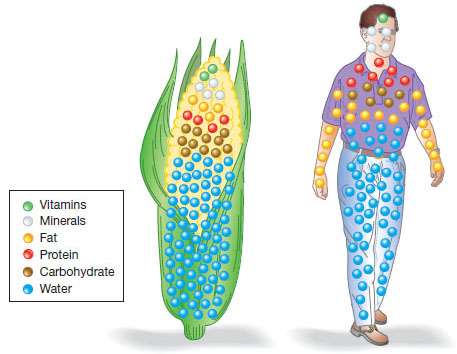
Six Classes of Nutrients and How They Help Us to Maintain Our Health Status
There are six classes of nutrients that are vital to the function of our bodies. These nutrients become fuel for the human body through food consumption and digestion. The infographic below shows how food and the human body are both made up of the same six materials, water, fat, carbohydrates, protein, vitamins, and minerals (Sizer & Whitney, 2016).

When the body moves and functions throughout the day, it uses energy. There are three energy-yielding nutrients called macronutrients: fats, carbohydrates, and proteins. “The carbohydrates and fats (also called lipids) are especially important energy-yielding nutrients. Protein does double duty: it can yield energy, but it also provides materials that form structures and working parts of body tissues (Sizer & Whitney, 2016). Vitamins and minerals (also called micronutrients), have the job of body regulation.
“As regulators, the vitamins and minerals assist in all body processes: digesting food; moving muscles; disposing of wastes; growing new tissues; healing wounds; obtaining energy from carbohydrate, fat, and protein; and participating in every other process necessary to maintain life”(Sizer & Whitney, 2016).
The sixth nutrient is water, which is continuously being depleted and replaced to keep the body tissues hydrated and cells functional (Sizer & Whitney, 2016). Understanding the six types of nutrients and how they maintain the body allows individuals to apply this knowledge when building a healthy diet.
The Digestive Tract: Purpose, Components and Absorption of Nutrients
The body breaks down food during digestion to be metabolized and used throughout the body as energy for all body functions. Vitamins and minerals in specific quantities are vital for human health. Once a person has eaten food, the brain and hormonal (endocrine) system direct the components of the digestive system to do work to digest and absorb the vitamins and minerals of the swallowed food. The infographic below shows the digestive tract and associated organs (Sizer & Whitney, 2016).
“The main function of the digestive system is to take food and fluids in from the external environment and to prepare nutrients, water and electrolytes into components that can be taken into the internal environment of the body, therefore providing raw materials and energy sources for cell activity. The digestive system is complex because it carries out many functions to ensure food is available in a form that allows cells to use it” (Johnstone et al., 2014).
The digestive tract is twenty-six feet of a flexible, muscular tube starting at the mouth and proceeding through the throat, esophagus, stomach, small intestine, large intestine, rectum, and anus (Sizer & Whitney, 2016). After eating something, for example, a bite of bread, it begins to follow the digestive tract through the throat, down the esophagus, and onward. The bread is still technically not inside the body, and it is still considered part of the external environment at this point. “Only when a nutrient or other substance passes through the wall of the digestive tract does it actually enter the body’s tissue” (Sizer & Whitney, 2016) and become a usable part of the body’s internal environment. This is why someone can accidentally swallow a foreign object such as gum or a marble, and it will remain intact, unabsorbed, and not truly enter the body, but instead exit as it entered, in a few days.

The Mechanical Aspect of Digestion: Key Mechanical Processes
There are three key pieces to the mechanical puzzle of digestion; the mouth, stomach, and intestine. “Mechanical digestion occurs where food is broken down into its smaller constituent parts, mixed with digestive juices, moved along the gastrointestinal tract, and removed from the body as feces. It consists of chewing, swallowing, peristalsis and defecation” (Hendry et al., 2014). “Peristalsis, a series of squeezing waves that start with the tongue’s movement during a swallow and pass down the esophagus” (Sizer & Whitney, 2016). Let us take a trip with the bite of bread that was mentioned in the previous paragraph. At the opening of the mouth, the lips guide and keep the bread in the mouth. The tongue guides the bread during chewing (mastication), forming a small ball of bread for swallowing (deglutition), and is also essential for tasting the bread at this time (Johnstone et al., 2014). The tongue is covered by taste buds that, when stimulated, create enjoyable feelings from the taste of the delicious bread (Johnstone et al., 2014). “The taste buds also stimulate the production of secretions from the salivary glands, stomach, pancreas, and gallbladder in preparation for the arrival of food in the digestive system” (Johnstone et al., 2014), which is part of the chemical process that will be discussed in the next section of this essay. After the bread is swallowed and arrives in the stomach, where more chemical aspects of digestion occur, the stomach muscles are responsible for the churning action that mixes the bread with gastric juice and breaks down the bread into a semi-solid consistency called chyme. The stomach muscles move food to the sphincter so that it opens, and then small amounts of bread-chyme are pushed through into the small intestine (Johnstone et al., 2014). When the bread-chyme has arrived in the large intestine, digestion and absorption are almost completed. The colon’s (large intestine) task is to “reabsorb the water donated earlier by digestive organs and to absorb minerals, leaving a paste of fiber and other undigested materials, the feces, suitable for excretion” (Sizer & Whitney, 2016). The whole process takes between twenty-four and seventy-two hours, from taking that first bite of bread with the mouth to final excretion (Sizer & Whitney, 2016). However, it is not just the mechanical-muscular work of chewing, waving, pushing, and squirting that matters. Throughout the digestive process, there is also a chemical component at work.
The Chemical Aspect of Digestion: Key Chemical Processes
The key players of the chemical digestion process are the same as the mechanical ones; the mouth, stomach, and intestine. “Chemical digestion occurs when food is broken down into absorbable units so that they can pass through the intestinal mucosa into the circulatory system” (Hendry et al., 2014). In the mouth, each bite of food is mixed with saliva by the teeth and the tongue. “The carbohydrate-digesting enzyme of saliva begins to break down the starch of food such as bread, banana, and peanut butter into sugars”(Sizer & Whitney, 2016). In the stomach, gastric juice mixes with the swallowed food. “Acid in the gastric juice unwinds proteins from the food then an enzyme clips the protein strands into pieces” (Sizer & Whitney, 2016). The watery, carbohydrate, and protein-rich part of the chyme enters the small intestine first, and a layer of fat follows (Sizer & Whitney, 2016). Sugars require little digesting and begin to cross the linings of the small intestine immediately on contact. Close by, the liver gives bile through a duct that blends the fat and chyme. The pancreas squirts enzymes to break down the fat, protein, and starch (Sizer & Whitney, 2016). “As the enzymes do their work, smaller and smaller chemical fragments are absorbed into the bloodstream and lymph along with vitamins and minerals, through the cells of the small intestine wall to nourish the body tissues (Sizer & Whitney, 2016). In the large intestine, “fiber fragments, fluid, and some minerals are absorbed, but most are not digested” (Sizer & Whitney, 2016) and then passes out the colon. Through all of this digestion and absorption, the body begins to utilize the food as fuel. However, some of the “fuel” can have a negative impact on the body and create digestive disorders.
Correlation Between Food Choice and Digestive Disorders
The correlation between personal health and food choice is directly linked. The digestive system plays a vital role in the health of the body because it is the bodily system responsible for making the foods one chooses to eat usable by the body to maintain health. When unhealthy food is eaten or when too little or too much food is eaten, the digestive system will not have the adequate nutrients to give to the rest of the body systems for use and could be negatively impacted in many ways. Lack of nutrients or abundance of harmful nutrients can cause disease and digestive disorders. Four primary digestive disorders are constipation, diarrhea, heartburn, and hiccups. Constipation can often be caused by poor diet, sedentary behavior, dehydration, or certain medication (Sizer & Whitney, 2016). Diarrhea is typically caused by poor diet, emotional stress, or irritation of the colon (Sizer & Whitney, 2016). Gastroesophageal reflux disease (GERD) can cause damage to other organs such as the esophagus, and taking acid-reducing drugs such as self-prescribed heartburn medicine, one can mask the symptoms and be unaware that they are dealing with GERD (Sizer & Whitney, 2016). Hiccups (spasms of both the vocal cords and the diaphragm) can result from irritation of the diaphragm, indigestion, or other causes such as eating too fast (Sizer & Whitney, 2016). Part of eating right is choosing food wisely, learning to be self-aware to eat the right portions at the right pace, and educating oneself on how the body operates so that one can manage it to maintain health, will add joy and vitality to life.
Summary
This blog explained the significant components of the digestive tract and how nutrition absorption works. It examined the mechanical and chemical processes of the digestive system and discussed common digestive disorders and their causes. The human body is a beautiful, working piece of art. Each body system works in union with every other piece, and part of the body to create, grow, maintain, and rejuvenate life. The digestive system plays a crucial role in that life by breaking down the food we eat. The materials of food are mechanically and chemically processed and changed for use by the digestive system. Humans should be aware of their nutrition habits and how food choice can impact their quality of life.
Stay MOTOvated!! Live MOTOvated!!
References
Hendry, C., Farley, A., McLafferty, E., & Johnstone, C. (2014). The digestive system: part 2. Nursing Standard, 28(25), 37–44.
Johnstone, C., Hendry, C., Farley, A., & McLafferty, E. (2014). The digestive system: part 1. Nursing Standard, 28(24), 37–45.
Sizer, F., & Whitney, E. (2017). Nutrition: Concepts and controversies (14th ed.) [E-book]. Cengage Learning. https://content.ashford.edu/books/Sizer.2199.17.1/



